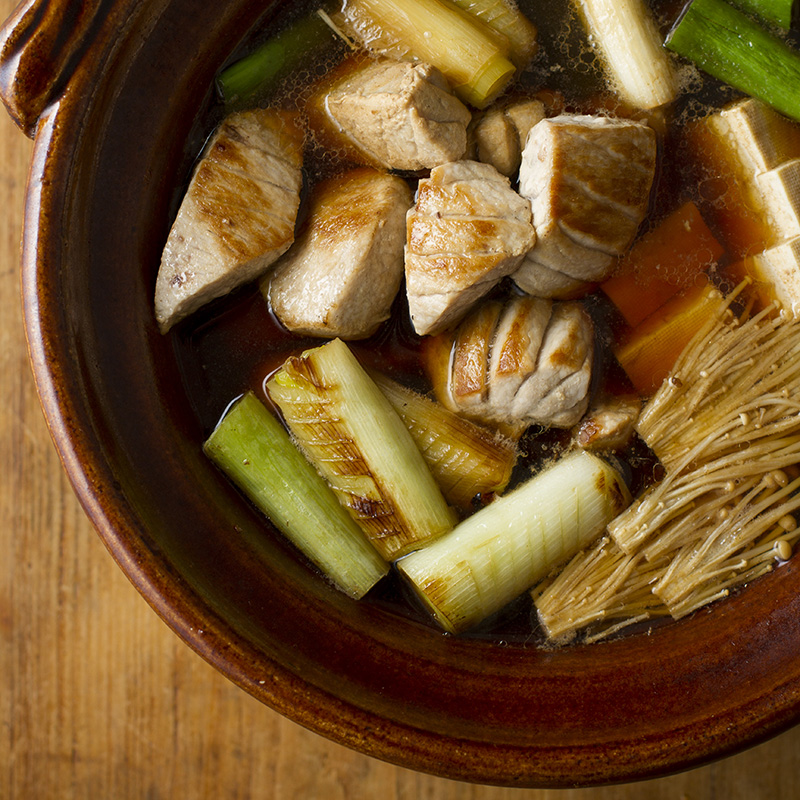An exceptional Maguro(Tuna) hotpot restaurant near a rundown station

Ordinary recipe of Negima Nabe (pot) .This picture is on web.
Have you ever heard of “Negima-nabe” which is one of our well-known hotpot cuisines? The Negima-nabe was especially popular among Tokyo neighborhoods in the old days.
This recipe initially uses the fatty portion of tuna called Maguro Toro, along with Japanese Green Onion and broth using bonito flakes.
In the olden days, Maguro Toro was not a preferable foodstuff among the locals for two reasons.

The ingredients for negima pot
One was because this part spoils easily when not stored in the fridge. Shoyu Marinade is one of the most reliable ways to keep foodstuff from spoiling, but this marinade recipe does not work for this part of Maguro. The second one is because Maguro toro tasted too fatty for these locals. So that fact made Maguro Toro a cheaper ingreadient.

Yoshidagura by Yoshida shuzouten

Kikusui by Aoshimashuzou
This, in turn, made Negima-nabe a very handy and popular seasonal (mostly winter) recipe among the locals. Negima-nabe paired with hot Sake in the cold season is another reason because such a low temperature generates more attractive pairing.
But time has changed a lot as fatty foods have became popular and refrigerators have now equipped most households everywhere.
In other words, Maguro Toro has become one of the expensive foodstuffs. Consequently, most of the restaurants dealing with NegimaーNabe usually categorize it as an expensive menu.

Owner chef of Negima
But Negima (the name of the restaurant) in Ikeburo offers it differently from others in terms of quality, hospitality, price, selection of Sake, and its ambiance. These outstanding differentiation gives the restaurant a strong presence to the new customers and help them to make a positive buzz to other potential customers. Such a buzzword helps Negima to outperform the competition in the gourmet-oriented people market, even though the location is a kind of rundown area.

negima served with small bowl ,Negima restaurant style
Let me tell you more detailed info about Negima’s.
-Price: Its price is wide-ranging depending on how many side dishes come with Negima-Nabe, such as a 3900yen course menu having 3 kinds of side dishes, plus cooked rice; or a 4900Yen course with 4 kinds of side dishes; or 5600yen course with the same number of side dishes but with some smoked dish added. For every course, cooked rice and Dashi Chazuke Gohan (broth poured over the rice using bonito flakes) come with the main dish. Food serving is small, but I was full after eating everything and drinking 3 kinds of Sake!

Appetizer-grilled Spanish mackerel, omelet roll, stewed vegetable
-Quality: It has such a respectable quality based on its elaborate recipe. Moreover, the owner-chef of Negima takes sensitive cooking strategies such as using just appropriate amount of ingredients like salt and Sake. For instance, the taste of the broth, using bonito flakes and Sake, was so delicate and clear that it could keep its Umami savour (well known as the hidden fifth taste) in your mouth even after sipping it. As a result, the broth made the taste of Negima pot to be so distinctive and unforgettable.

Kyutouryu by Kokuryu shuzo
-Sake: The menu book features more than 12 kinds of Sake, but actually Negima only served six kinds from the list. All of the six sake brands seemed suitable for hot Sake. The recipe for warming sake was so sensitive that the flavor of hot Sake enhances the savour of each food. I drank three kinds of Sake from the day’s selection all at a hot temperature; all of them worked pleasantly as a complement to each food.

Grilled mackerel
-Hospitality and the way of service: Negima provides a unique way to serve the Negima-pot. Originally, Negima-pot was a casual food, so that it was served with a pot on the table, and customers enjoyed sharing it with each other using each one’s own chopstick. In this way, the foodstuffs in the pot are kept warm, (and maybe warm the hearts, too, to create friendship among the eaters). But at Negima, the hotpot ingredients are served by the chef in small portions using small bowls. She provides very attentive concern when to refill the pot. Moreover, the eater can enjoy admirably cooked Maguro toro, not well-done, more like medium-rare. Her serving way means she could develop a new strategy to show her attentive service mind to the customers. It creates value-added for a brand which is a kind of brand new business model.

sweet beans dessert ,Zenzai in Japanese
-Ambiance: Negima is not spacious but produces a friendly mood among its customers sitting by the counter table even though they may be strangers to each other. The facade and the inside décor are not fancy but comfortable. The location is less than three minutes away (on foot) from the rundown Kitaikebukuro station, which is one stop from Ikebukuro on Toujyosen line.

exterior of Negima
Another fact-finding is an impressive recipe for grilled fish, using mackerel on that day.
I am ashamed to say, I have never enjoyed such a delicate cooking technique for grilled fish. The owner-chef said she uses regular electric grill equipment. However, the impression of the taste was quite beyond my imagination. The recipe of cooked rice was impressive as well.
In conclusion, I would say, if you like to prove your sensitivity for Japanese food and to get a deep understanding of it, Negima is one of the recommendable eating spots. Negima encourages you to learn how attentive serving and cooking manner for the customers is still carried out in Japan even at a non-star restaurant. (Actually, Negima is listed in the Michelin Guide Bib Gourmand list 2020!)

